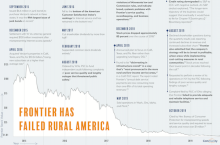Satellite Subsidies Will Widen Digital Divide in Rural America
The federal government is about to spend more than $120 million on subsidies that, rather than improving rural connectivity, will make tens of thousands of families worse off.
These funds are part of a 2018 federal program intended to expand rural broadband access called the Connect America Fund phase II (CAF II) reverse auction. The program, in which Internet access providers competed for subsidies, will distribute nearly $1.5 billion over the next 10 years to connect unserved rural residents. But in some communities, the auction may do more to widen the digital divide than diminish it.
While some winning bidders committed to building out high-speed fiber optic networks, satellite company Viasat will rake in more than $120 million in subsidies to continue providing inadequate geostationary satellite connectivity to rural households that are clamoring for something better. Not only does satellite Internet access offer slower speeds, greater latency, and less reliability for a higher cost compared to other technologies, but Viasat’s subsidies are making those areas ineligible for future broadband funds, deterring other providers from building truly high-quality networks. Instead of bridging the digital divide, the process will relegate certain communities to satellite Internet access while others receive ultra-fast fiber and do nothing more than deepen the fissure.
Mo’ Money . . .
The Connect America Fund (CAF) is a multi-phase subsidy program that supports improved connectivity in rural, high-cost areas as part of the Federal Communications Commission's (FCC’s) Universal Service Fund. The most recent phase of the program, the CAF phase II reverse auction, auctioned off regions to providers using a complicated formula that prioritized bids for low subsidy amounts and high-quality service.
Previous rounds of CAF mainly subsidized the large incumbents, such as AT&T and CenturyLink, but for the reverse auction, the FCC opened participation to other entities, including non-traditional providers like electric cooperatives. Eligible areas included rural locations where the incumbents had previously refused subsidies (and the accompanying commitment to expand Internet access).



